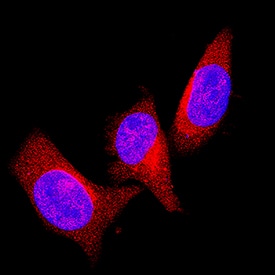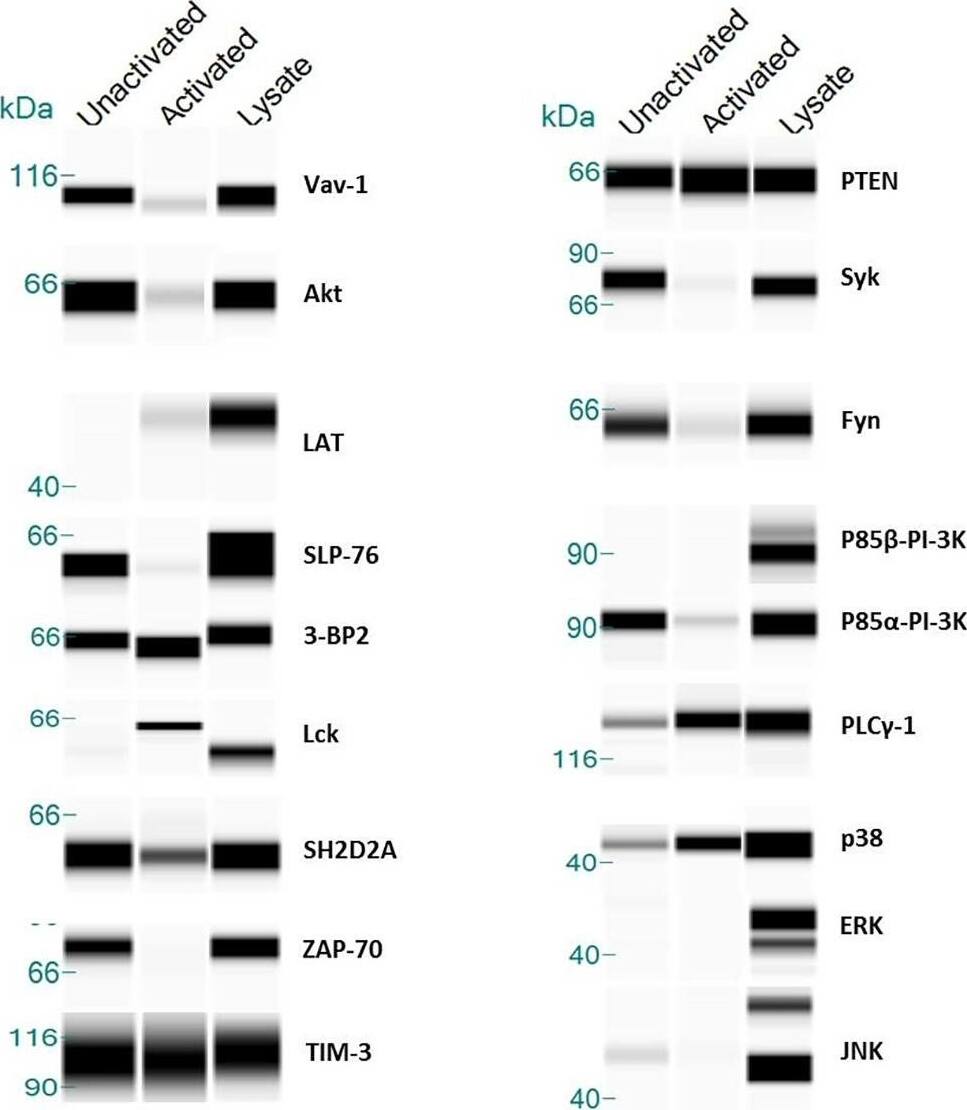Human PTEN Antibody
R&D Systems, part of Bio-Techne | Catalog # AF6655

Key Product Details
Species Reactivity
Validated:
Cited:
Applications
Validated:
Cited:
Label
Antibody Source
Product Specifications
Immunogen
Thr2-Val403
Accession # P60484
Specificity
Clonality
Host
Isotype
Scientific Data Images for Human PTEN Antibody
PTEN in Human Liver.
PTEN was detected in immersion fixed paraffin-embedded sections of human liver using Goat Anti- Human PTEN Antigen Affinity-purified Polyclonal Antibody (Catalog # AF6655) at 10 µg/mL overnight at 4 °C. Before incubation with the primary antibody, tissue was subjected to heat-induced epitope retrieval using Antigen Retrieval Reagent-Basic (Catalog # CTS013). Tissue was stained using the Anti-Goat HRP-DAB Cell & Tissue Staining Kit (brown; Catalog # CTS008) and counterstained with hematoxylin (blue). Specific staining was localized to cytoplasm of hepatocytes. View our protocol for Chromogenic IHC Staining of Paraffin-embedded Tissue Sections.PTEN in Neuro‑2A Mouse Cell Line.
PTEN was detected in immersion fixed Neuro-2A mouse neuroblastoma cell line using Goat Anti-Human PTEN Antigen Affinity-purified Polyclonal Antibody (Catalog # AF6655) at 1.7 µg/mL for 3 hours at room temperature. Cells were stained using the NorthernLights™ 557-conjugated Anti-Goat IgG Secondary Antibody (red; Catalog # NL001) and counterstained with DAPI (blue). Specific staining was localized to cytoplasm. View our protocol for Fluorescent ICC Staining of Cells on Coverslips.Detection of Human PTEN by Simple Western
TIM-3 Association with Intracellular Kinases in CD8+/MART-1+ T cells.TIM-3 co-immunoprecipitation analysis of unactivated and 15 min. stimulation with anti-CD3/CD28 beads (activated). Equivalent amounts of protein (~2mg) were co-immunoprecipitated with pAb anti-TIM-3 antibody and western blot was performed using capillary electrophoresis. Cleared lysate served as a loading control for individual antibody reactivity. Image collected and cropped by CiteAb from the following publication (https://dx.plos.org/10.1371/journal.pone.0140694), licensed under a CC-BY license. Not internally tested by R&D Systems.Applications for Human PTEN Antibody
Immunocytochemistry
Sample: Immersion fixed Neuro-2A mouse neuroblastoma cell line
Immunohistochemistry
Sample: Immersion fixed paraffin-embedded sections of human liver
Reviewed Applications
Read 1 review rated 5 using AF6655 in the following applications:
Formulation, Preparation, and Storage
Purification
Reconstitution
Formulation
Shipping
Stability & Storage
- 12 months from date of receipt, -20 to -70 °C as supplied.
- 1 month, 2 to 8 °C under sterile conditions after reconstitution.
- 6 months, -20 to -70 °C under sterile conditions after reconstitution.
Background: PTEN
The tumor suppressor gene PTEN (phosphatase and tensin homolog deleted on chromosome 10), also known as MMAC1 (mutated in multiple advanced cancers 1), encodes a phosphatase that contains the catalytic signature motif (HCXXGXXRS/T) found in all members of the protein tyrosine phosphatase family. In vitro, the recombinant PTEN has both lipid phosphatase and protein phosphatase activities (1, 2). Interestingly, accumulating evidence has shown that the tumor suppressor activity of PTEN relies on its ability to dephosphorylate phosphatidylinositol (3, 4, 5)-triphosphate specifically at position 3 of the inositol ring (3). This activity reduces the levels of phosphatidylinositol (3, 4, 5)-triphosphate which is specifically produced from phosphatidylinositol (4, 5)-diphosphate by PI 3-kinase upon activation by a variety of stimuli. Therefore, PTEN antagonizes PI 3-kinase-induced downstream signaling events and cellular processes including cell growth, apoptosis and cell motility. In vivo, the importance of PTEN catalytic activity in its tumor suppressor functions is underscored by the fact that the majority of PTEN missense mutations detected in tumor specimens target the phosphatase domain and cause a loss in PTEN phosphatase activity (4).
References
- Maehama, T. and J. Dixon (1998) J. Biol. Chem. 273:13375.
- Das, S. et al. (2003) Proc. Natl. Acad. Sci. USA 100:7491.
- Myers, M. et al. (1998) Proc. Natl. Acad. Sci. USA 95:13513.
- Waite, K. and C. Eng (2002) Am. J. Hum. Genet. 70:829.
Long Name
Alternate Names
Gene Symbol
UniProt
Additional PTEN Products
Product Documents for Human PTEN Antibody
Product Specific Notices for Human PTEN Antibody
This product is covered by the following U.S. patent: USSN # 10/299,003.
For research use only


